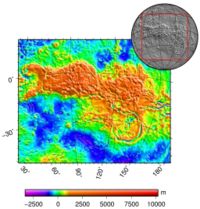Aphrodite Terra
 Topography of western Aphrodite Terra | |
| Coordinates | 10°S 100°E / 10°S 100°E |
|---|---|
| Diameter | 10,000 km |
| Eponym | Aphrodite |
Aphrodite Terra /æfroʊˈdaɪtiː ˈtɛrə/ is one of the three continental regions on the planet Venus, the others being Ishtar Terra and Lada Terra. It is named for Aphrodite, the Greek equivalent of the goddess Venus, and is found near the equator of the planet. Aphrodite Terra is about half the size of Africa, making it the largest of the terrae.[1]
Description
This section needs additional citations for verification. (April 2021) |
Aphrodite Terra was named by the International Astronomical Union, the governing body for planetary and satellite nomenclature, after Aphrodite, the goddess of love.[2] The name was chosen because Aphrodite is the Greek equivalent of the Roman goddess Venus.[1]
Located near the equator of Venus, Aphrodite Terra has an area about half the size of Africa, and is much larger than the rougher Ishtar Terra. It is covered with deep rift valleys.[3] Like Ishtar Terra, Aphrodite Terra also has mountain ranges but they are only about half the size of the mountains on Ishtar.[citation needed]
Extending nearly two thirds around the planet,[4] Aphrodite Terra's topography appears buckled and fractured which suggests large compressive forces. There are also numerous extensive lava flows across this terrain[5] and some have an interesting bow shape to them due to atmospheric gravity waves.[6]
Aphrodite Terra has two main regions:
Gallery
-
Radar image and topography of the western Aphrodite Terra
-
Color-coded elevation map, showing the elevated "continents" in yellow: Aphrodite Terra is just below the equator to the right.Pioneer Venus Orbitercollected these data with radar.
-
Visible light image of Venus with Ovda Regio plateau of Aphrodite Terra visible, in a first view of the surface of Venus from space (Parker Solar Probe, July 2020)
-
Parker Solar Probe images showing features on the Venusian surface, such as the continental region Aphrodite Terra, the Tellus Regio plateau, and the Aino Planitia plains.
See also
References
- ^ a b Russell, Randy (2009). "Venus Continents". Windows to the Universe. Retrieved 2021-04-10.
- ^ "The Magellan Venus Explorer's Guide". www2.jpl.nasa.gov. Retrieved 2021-04-11.
- ^ Russell, Randy (2009). "Aphrodite Terra". Windows to the Universe. Retrieved 2021-04-10.
- ^ "Theories About Aphrodite Terra Tested". NASA Jet Propulsion Laboratory (JPL). Retrieved 2021-04-10.
- ^ a b Christiansen, Eric. "Chapter 7. Venus". explanet.info. Retrieved 2021-04-10.
- ^ "Appearance of the large bow-shaped feature observed by Akatsuki turned out to be a mysterious phenomenon occurring every Venusian day | Study". Venus Climate Orbiter AKATSUKI. Retrieved 2021-04-10.
Bibliography
1. D. A. Senske, "Geology of the Venus equatorial region from Pioneer Venus radar imaging," Part 3 Regional Geology, Earth, Moon, and Planets, July 1990, Volume 50, Issue 1, Springer, pp 305–327.
2. L. S. Crumpler, "Eastern Aphrodite Terra on Venus: Characteristics, structure, and mode of origin," Part 3 Regional Geology, Earth, Moon, and Planets, July 1990, Volume 50, Issue 1, Springer, pp 343–388. (Page 1).




